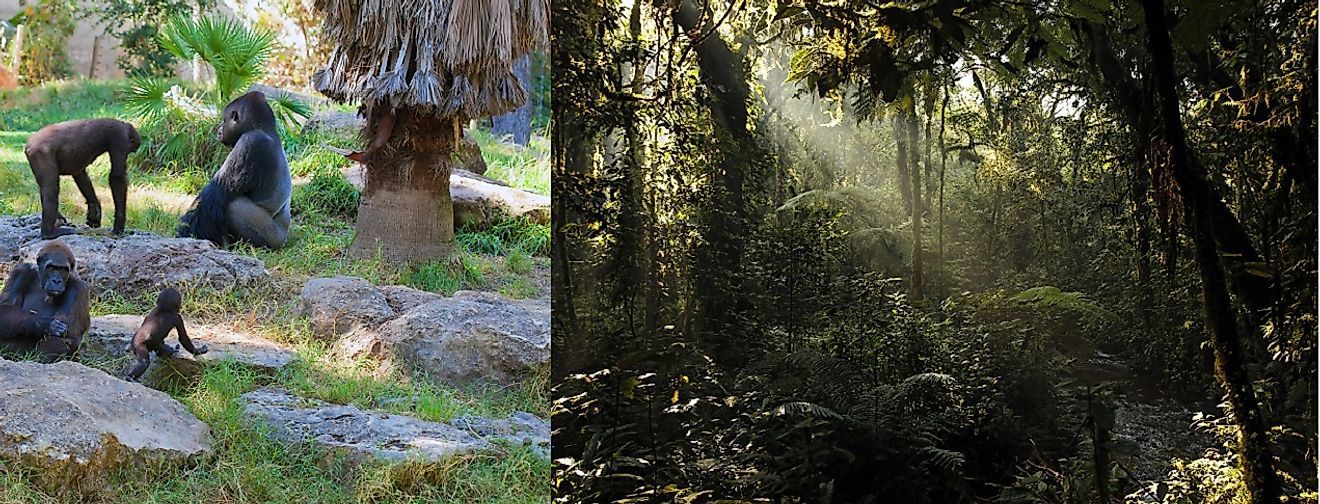UNESCO World Heritage Sites In Uganda

Uganda is a landlocked country in East Africa that borders Kenya, Tanzania, Rwanda, South Sudan, and the Democratic Republic of the Congo. It is the second most populous landlocked country in the world after Ethiopia. Lake Victoria is in the southern part of the country, and it shares the lake with Kenya and Tanzania. The country is in the African Great Lakes region and lies within the Nile basin. Uganda has some of the sites identified by UNESCO as world heritage sites. One of the sites is the royal tombs at Kasubi, while the other two are Bwindi Impenetrable National Park and Rwenzori Mountains National Park.
Bwindi Impenetrable National Park
The Bwindi Impenetrable National Park was listed by UNESCO as a World Natural Heritage site 1994. It is in southwest Uganda and occupies 32,000 hectares of land. It is mainly covered by an impenetrable forest. The forest is a small portion of the forest that once covered parts of Rwanda, Burundi, the Democratic Republic of the Congo, and Uganda. It has a broad range of plant and animal spices. It is also home to some endangered species, the most notable being the Mountain gorilla. Half of the world’s Mountain gorillas live in Bwindi National Park. Its habitat is diverse with altitudes ranging between 1160 and 2706 meters above sea level. It is, therefore, able to accommodate different plant and animal species. The park is inhabited by more than 300 bird species, over 200 butterfly species, 120 mammal species, and 27 reptile species. In addition to wildlife, the park has over 200 tree species and 104 fern species. Bwindi National Park prides itself as home to many endemic species. The park is under state protection since it was declared a national park in 1991. Trees and concrete pillars line the park’s boundary. Adjacent communities do not have access to the forest, but they engaged in ecotourism programs that benefit the whole community.
Rwenzori Mountains National Park
The Rwenzori Mountains National Park was also listed as a Natural World Heritage Site in 1994 by UNESCO. It is an alpine area found in the western Uganda covering around 100,000 hectares. The park’s natural beauty is profound and attracts tourists from around the world. It boasts of magnificent glaciers, beautiful lakes, and breathtaking waterfalls. Additionally, the snow-capped peaks, clear rivers, and unique flora add to the park’s beauty. It has the third largest mountain in Africa standing at 5109 meters. The park is a permanent source of River Nile. Rwenzori Mountains National Park also has diverse plants and animal species most of which are endemic. The park is managed by Uganda Wildlife Authority. It has clearly marked boundaries that reduce invasion into the park by local communities. However, more resources are needed to conserve the park and to stop encroachment.
Tombs of the Buganda Kings at Kasumbi
The Kasumbi Tombs are found on the hillsides outside of Kampala City. The tombs are the burial grounds for royals of the Buganda Kingdom. Four kabakas (kings of Buganda) and other family members are buried within the site. The tombs are significant as they showcase the great architectural work done by the Baganda people. These architectural designs were developed in the 13th Century and have survived into the present day and age. The burial grounds have religious significance for the Baganda. Numerous religious rituals are performed at the site. Additionally, Kasumbi tombs form a cultural center were Baganda culture is preserved. In 2010, a fire destroyed the Kasumbi tombs, but it has been reconstructed with the help of Japanese government. The Buganda Kingdom manages the site and ensures that its authenticity is preserved. The Ugandan government has also put into place measures to protect the world heritage site. UNESCO listed the tombs in 2010 as a cultural world heritage site, and it is also listed as an endangered site due to the threats to its conservation.
UNESCO World Heritage Sites In Uganda
| UNESCO World Heritage Sites in Uganda | Year of Inscription; Type |
|---|---|
| Bwindi Impenetrable National Park | 1994; Natural Site |
| Rwenzori Mountains National Park | 1994; Natural Site |
| Tombs of Buganda Kings at Kasubi | 2001; Endangered Cultural Site |







